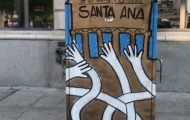Fourth and Main Streets
Fourth and Main streets are the heart of the Latino business community of Santa Ana, known as “La Calle Cuatro.” As the retail center of Historic Downtown Santa Ana, most of its building are two-story half or full-block structures, and have architectural details common to the early 20th century, such as brick construction, arching windows, and large window fronts. Trees line the two-lane streets, with groups of pedestrians walking comfortably on the large sidewalks.
From this intersection, a visitor can walk three blocks in any direction and likely find storefronts displaying specials or services written in Spanish or English. Latino small businesses have characterized the area following World War II, when the more affluent middle-class stores moved to the shopping malls on the suburban outskirts of the city. In the mid-1990s, efforts to gentrify “La Cuatro” picked up in earnest with the intention to bring in investment and consumption by attracting more affluent developers, visitors, and residents. Many community-based groups have formed to increase the agency of existing local residents and business owners in city planning. In 2012, the adoption of a “Sunshine Ordinance” allowed residents to participate in proposed development projects that are set before the Santa Ana City Council.
Sources:
1. Erualdo R. González and Carolina S. Sarmiento, “The Gentrification of Santa Ana: From Origin to Resistance,” KCET, September 13, 2017.
2. “Santa Ana Community Arist(a) Coalition Fight Against Red Tape to Paint Downtown Mural,” OC Weekly, February 14, 2017.
2014
Life in the Golden City
Life in the Golden City is a 4-panel mural painted on a utility box highlighting Santa Ana’s iconic landmarks. Each panel features a golden-painted silhouette of a historic building in Santa Ana.
The panel facing north features the swirling, Churrigueresque flourishes of the Santora building, which became a symbol of local artist community resistance over the future of Downtown Santa Ana; the Santora building had recently changed ownership causing concern among the artist community.
The panel facing the sidewalk shows the silhouette of the Spurgeon Building, and the meter of the utility box is used to suggest the building’s iconic clock tower.
The panel facing Main Street features the Santa Ana Water Tower, with the writing “Downtown Santa Ana” mirroring the current city’s slogan on the Tower, “Downtown Orange County.”
The panel facing south depicts the more than 100-year-old Old Orange County Courthouse, which has currently been converted into the Orange County History Center.
Thick gold lines suggesting sunrays crown the tops of the buildings. The lines of the sunrays are a feature in pop art expression, as well as part of the Orange County sunshine mythos. The mythos extends to the bright blue color used as the background of the mural, suggesting clear skies and good weather. Meanwhile, white wavy arms spring from the base of the mural, reaching upward towards the sunrays. With only four fingers, the white hands are cartoonish and add a playful element.
Artist Roger Reyes painted a hidden message on he top of the utility box: “art is for everybody.” Attributed to the late artist and social activist Keith Haring, the quote reflects Reyes' own approach to creating art outside of a museum or gallery space.
The mural one of the seven utility boxes the Santa Ana City Council commissioned as part of the "Utility Box Art Project" that began in 2014.
Sources:
1. Jeff Kass, "Spurgeon Building on 2nd Historic List," Los Angeles Times, April 5, 1996.
2. "Santa Ana’s landmark tower: What is it? What does it do?" The Orange County Register, July 30, 2013.
3. "Old Orange County Courthouse," OC Parks.
4. Jessica Kwong, "Santa Ana adopts 10-year plan to develop role of arts and culture," The Orange County Register. August 17, 2016.
5. Ron Gonzales, "Coming to Santa Ana: Utility box art," The Orange County Register. January 11, 2014.
1 Related Artists




